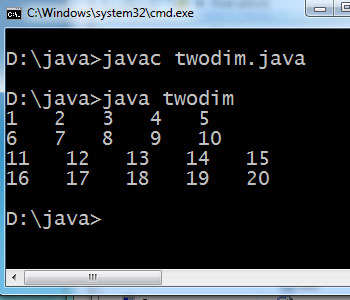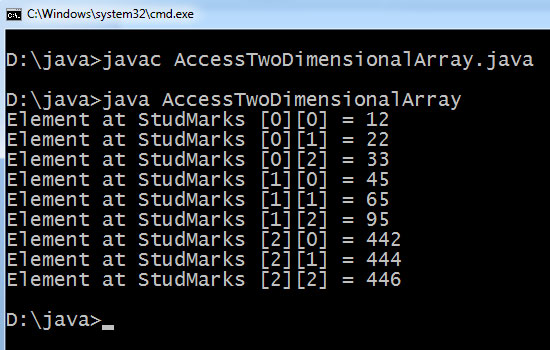
2D Array in Java
In Java, multidimensional arrays are also applied as arrays of arrays. 2D(two-dimension i.e tabular form) array is the generally used and simplest multi-dimensional array(like excel sheet(grids)). 2D arrays are represented in a row-columns([3][4]) form, and the terms “rows”[3] and “columns”[4] are used in computing.
Syntax….
Declaration – Syntax:
Data_Type[][] Array_Name = new int[Row_Size][Cols_Size];
For example: int[][] arr = new int[10][20];
- Row_Size: Number of Row elements an array can store. In this example, Row_Size = 10, then the array will have ten rows.
- Cols_Size: Number of Column elements an array can store. In this example, Cols_Size = 20, then the array will have 6 Columns.
- int is the data type
- arr is the name of the array
How to Initialize Array in Java
Initialization – Syntax:( Accessing Elements of Two-Dimensional Arrays)
array_name[row_index][column_index] = value;
For example: arr[0][0] = 1;
The above example represents the element present in the first row and first column.
For example: int[][] arr_values = {{11, 12}, {13, 14}};
- Data_type(int): It decides the type of elements it will accept. For illustration, If we want to store integer values( without decimal like 4,6,80), then we use (int) data type. If we want to store Float values(decimal values like 3.45,7.89f), then we use (float)data type. If we want to store character values(‘s’,’u’) then we use the (char) data type.
- Array_Name(arr_values): This is the name(here arr_values is the name of the array) to give it to this Java two dimensional array(arr_values[][]).
- How to initialize 2d array in Java
arr_values [0][0]=11;
arr_values [0][1]=12;
arr_values [1][0]=13;
arr_values [1][1]=14;
Two-Dimensional array in Java Example
class twodim
{
public static void main(String ana[])
{
int aa,bb;
int table[][]=new int[4][5];
for(aa=0;aa<4;++aa)
{
for(bb=0;bb<5;++bb)
{
table[aa][bb]=(aa*5)+bb+1;
System.out.print(table[aa][bb]+” “);
}
System.out.println();
}
}
}

Explanation…
In this example, a class two dim (name of the class)is created. In the main method, two integer variables aa, and bb are declared, which are used for the two-dimensional array. Then, a two-dimensional array is created (int table[][]=new int[4][5]), which is linked to a reference variable table of the array. After this, first for loop is used, where in variable aa is initialized to 0, and aa condition aa<4 is checked.
If the condition aa<4 is true(outer loop) , second for loop starts(inner loop). (for(aa=0;aa<4;++aa)
for(bb=0;bb<5;++bb))
In this for loop
for(bb=0;bb<5;++bb)
bb=0 initialization
bb<5 condition
++bb increment
first, the value of bb is initialized to 0(bb=0)
Then, the condition bb<5 is checked.
If the condition(inner loop) bb<5 is true, table[aa][bb] is assigned a value that comes as a result of (aa*5)+bb+1;
Then the System.out.print(table[aa][bb]+” “); statement is used to print the value(aa is for rows and bb is for cols) that is assigned to table[aa][bb].
How to print a 2d array in Java
public class AccessTwoDimensionalArray
{
public static void main(String[] args)
{
int[][] StudMarks = { {12, 22, 33},{45, 65, 95},{442, 444, 446},{785, 786, 787}};
System.out.println("Element at StudMarks [0][0] = " + StudMarks [0][0]);
System.out.println("Element at StudMarks [0][1] = " + StudMarks [0][1]);
System.out.println("Element at StudMarks [0][2] = " + StudMarks [0][2]);
System.out.println("Element at StudMarks [1][0] = " + StudMarks [1][0]);
System.out.println("Element at StudMarks [1][1] = " + StudMarks [1][1]);
System.out.println("Element at StudMarks [1][2] = " + StudMarks [1][2]);
System.out.println("Element at StudMarks [2][0] = " + StudMarks [2][0]);
System.out.println("Element at StudMarks [2][1] = " + StudMarks [2][1]);
System.out.println("Element at StudMarks [2][2] = " + StudMarks [2][2]);
}}



